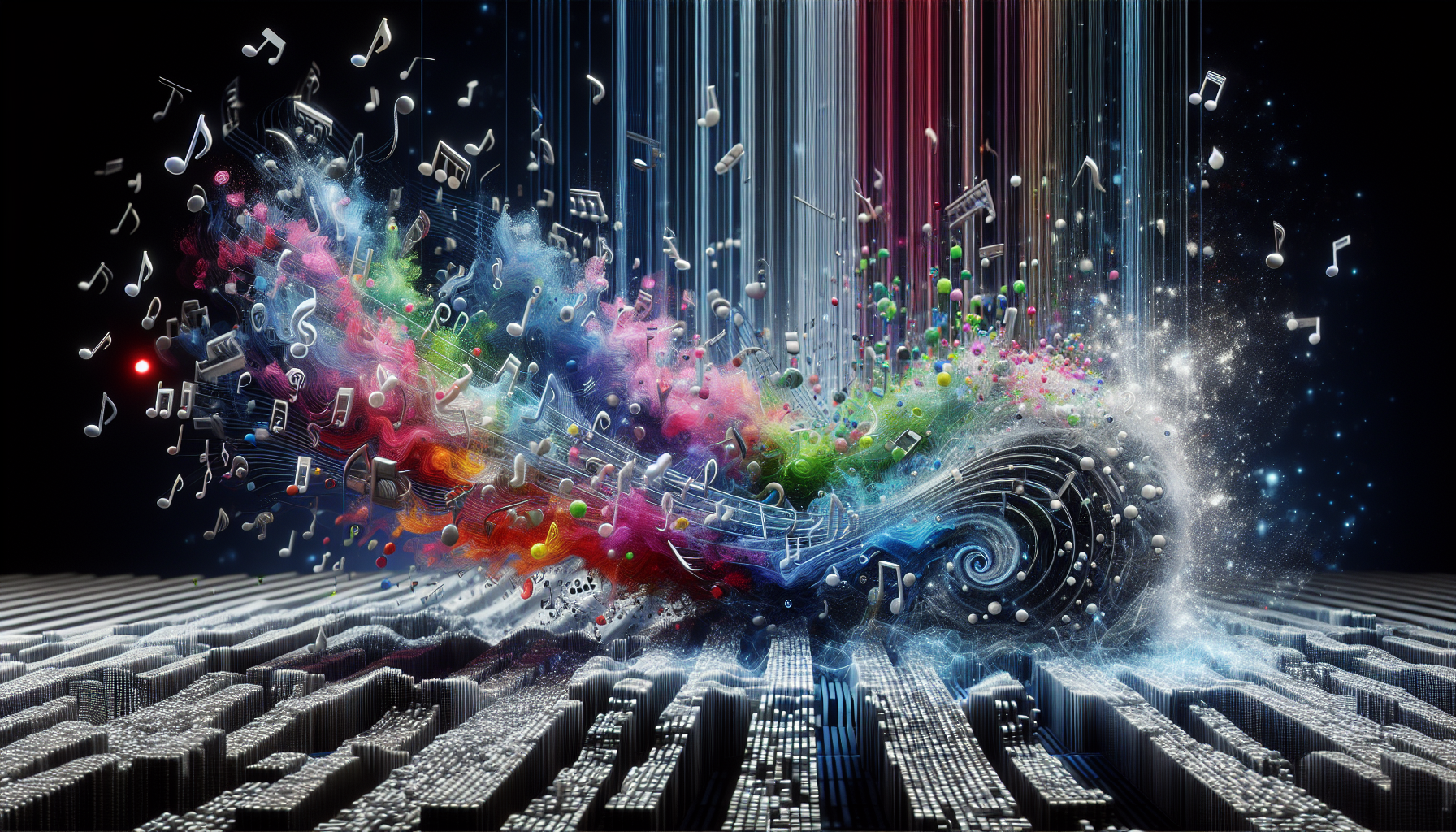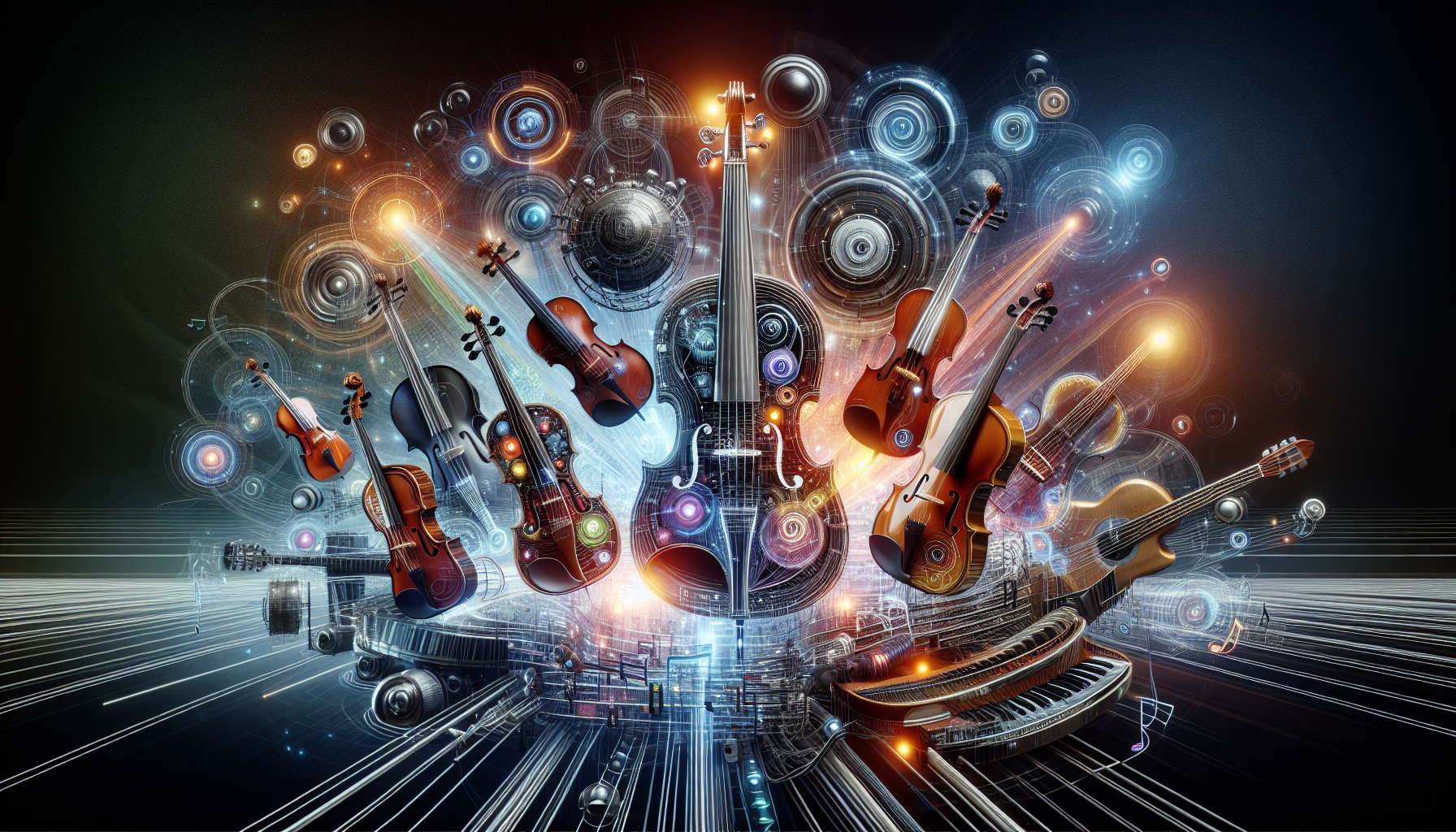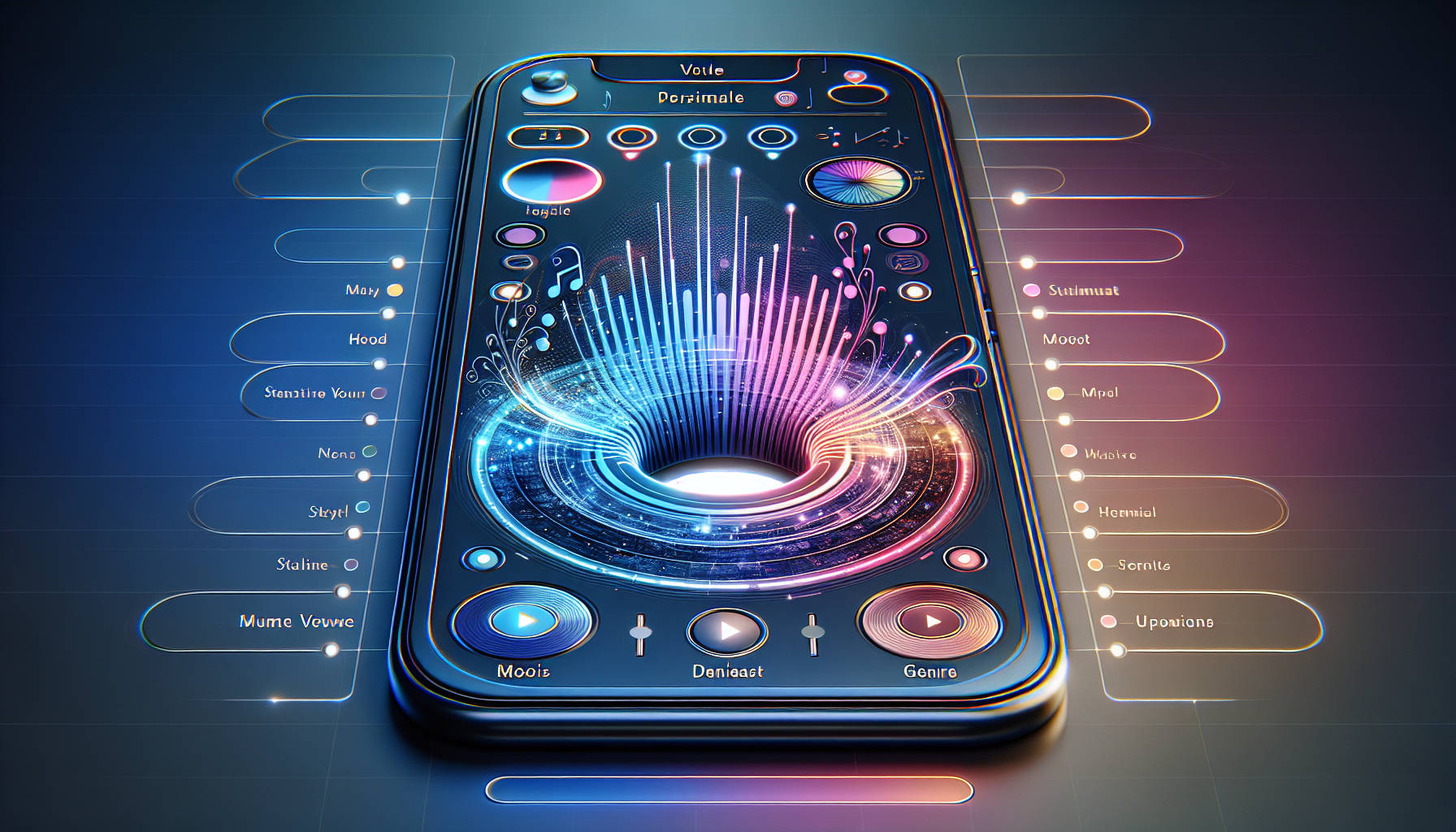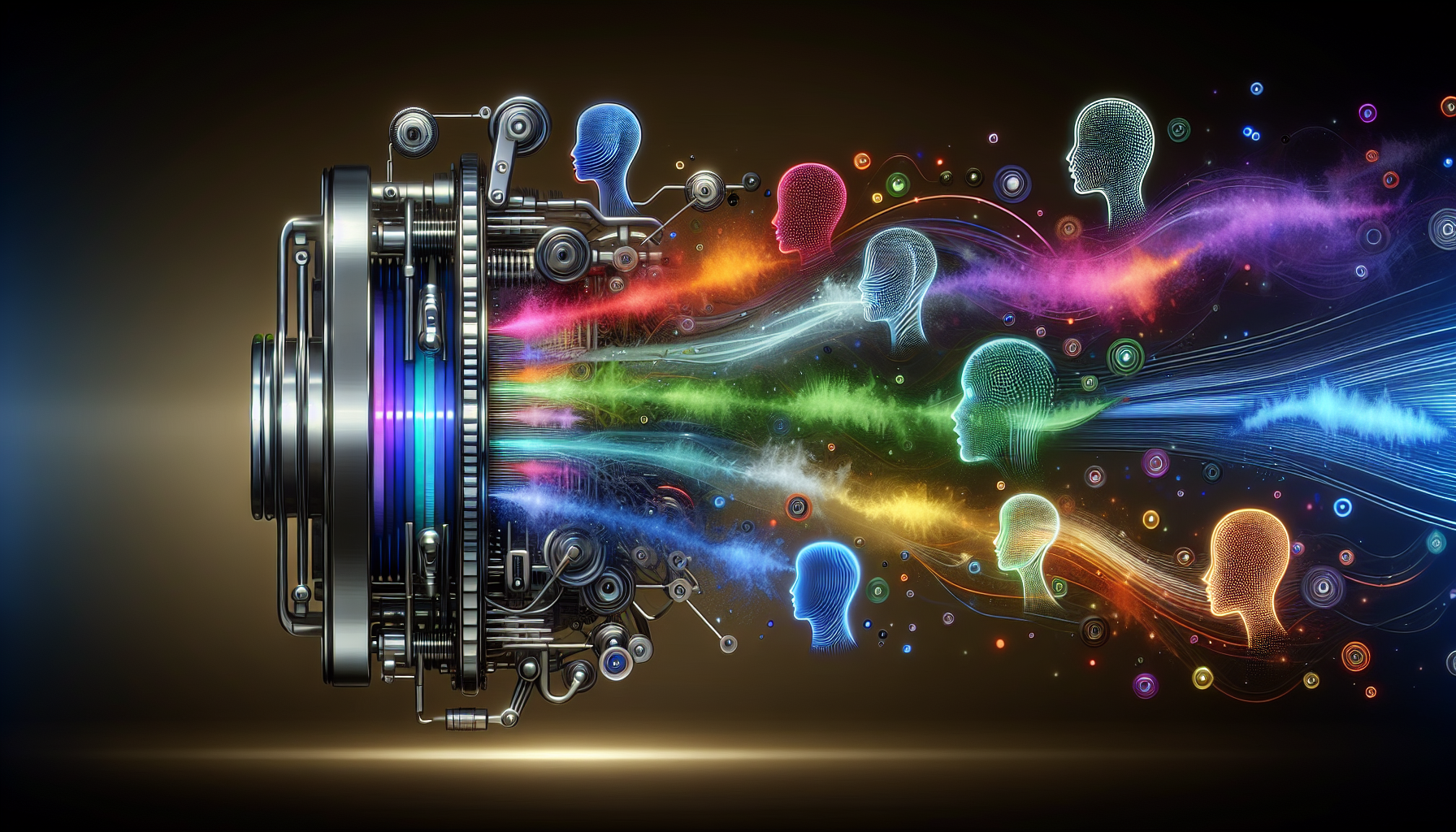Paul
May 2, 2024
Table of Contents |
Wondering how AI-generated music works and its implications for the industry? Explore the software pushing the boundaries of digital composition, the ease with which musicians can generate tracks, and the potential challenges surrounding this innovative technology. This article will offer you a clear understanding of AI music generators – equipping you with the knowledge to navigate this evolving landscape.
Key Takeaways
- AI is transforming music production by providing tools that enable rapid creation of songs across genres, while inviting debate on its impact on creativity and copyright issues.
- AI music generators analyze existing songs to create new ones, offering features like melody and harmony generation, vocal and instrument separation and real-time editing.
- AI-generated music offers major customization, allowing creators to tailor tracks by mood, genre, and instruments, with apps like Lalals.com providing personalized user experiences, while also complying to the emerging legal landscape of copyright and commercial use.
What is AI Generated Music?

AI-generated music is a process where artificial intelligence composes, arranges, and even performs music by analyzing musical data. This technology uses machine learning models and algorithms to create melodies, harmonies, and rhythms, allowing musicians to explore new creative horizons. AI-generated music spans various genres, including pop, jazz, electronic, and classical, providing artists with powerful tools for producing high-quality music.
How Machine Learning Models Work for AI Music GeneratorsMachine learning models are algorithms that allow computers to learn from data and make decisions or predictions without being explicitly programmed. In the context of AI music generators, machine learning models are trained on large datasets of musical compositions to understand patterns, rhythms, melodies, and harmonies. These models then use this information to generate new, original music that mimics the styles they’ve learned from the training data. |
Today, several AI music creation platforms are leading the way by offering unique features. Let’s take a look at some of the most prominent AI song creation apps and what makes them stand out:
Lalals.com Lalals is an AI-powered tool designed to streamline the music creation process. Known for its user-friendly interface, Lalals allows musicians to produce professional-grade music with minimal effort. What sets Lalals apart is its focus on high-quality voice cloning and stem separation technology, making it ideal for those who want to isolate instrumental tracks or add customized vocals to their compositions. Lalals also ensures no legal issues with distributing the content commercially, making it a top choice for artists who want to sell or share their creations. |
Melobytes Melobytes offers an innovative approach by transforming text into music. The platform allows users to create songs by inputting lyrics or poems, which are then turned into melodies. This unique feature makes Melobytes perfect for songwriters or poets looking for inspiration in composition. Melobytes stands out because it provides automated melody generation based on textual input, ensuring each composition is unique and tailored to the user’s needs. |
Google Magenta Google Magenta is an open-source research project that explores how AI can assist in creating art and music. Unlike other tools, Magenta focuses on enabling users to integrate machine learning models into their creative processes. What makes Magenta unique is its collaborative nature, where users can customize their musical compositions using AI-generated melodies and rhythms while having full control over the artistic direction. |
MuseNet Developed by OpenAI, MuseNet is known for its ability to generate music using deep learning. MuseNet can create compositions with up to 10 different instruments and in various styles, making it a versatile tool for musicians looking to experiment across genres. What sets MuseNet apart is its capacity to generate complex, multi-instrument compositions, enabling artists to produce orchestral pieces, electronic tracks, or jazz ensembles effortlessly. |
The Rise of AI in Music Production
AI’s journey in music production has been nothing short of groundbreaking. What started with basic computer-generated sounds has transformed into a highly sophisticated toolset that assists musicians in creating everything from simple melodies to complex symphonies. Over the decades, AI has advanced from early experiments to mainstream music creation, becoming an integral part of the music industry.
This timeline highlights key milestones, showing how AI evolved from simple beginnings in the 1950s to the advanced technologies shaping the music industry today. Each step marks a significant shift, not only in how music is made but also in how artists approach creativity. Let's take a closer look at the fascinating evolution of AI in music:
⏳1950s - Early BeginningsThe first computer-generated music is created by Alan Turing's machine, which plays simple tunes like "God Save the King". |
💻1980s - Early ApplicationsThe advent of computer-based music composition tools begins, with early AI programs designed to assist in composing classical music. |
🎼1990s - Algorithmic MusicDavid Cope develops "Experiments in Musical Intelligence" (EMI), an AI system that composes music in the style of classical composers. |
📈2000s - Commercial ApplicationsIntroduction of more sophisticated AI tools like Band-in-a-Box and Amper Music, allowing for the creation of background music and simple compositions. |
🌍2016 - AI Becomes Mainstream
|
🤖2017 - Deep Learning and Neural NetworksTaryn Southern releases her album "I AM AI", which is fully composed and produced using AI tools like Amper Music and IBM Watson Beat. |
🎵2018 - AI in Music ToolsGoogle's Magenta project introduces AI tools for musicians, including AI-generated melodies and rhythms that assist in the creative process. |
🤝2019 - AI and Collaboration
|
🎤2020 - Advancements in AI VocalsThe AI music creation platform AIVA (Artificial Intelligence Virtual Artist) is used to compose a diverse range of music, including symphonies and pop songs. |
🌟2021 - AI in Popular MusicHolly Herndon releases "Proto", an album featuring AI-generated vocals, emphasizing the integration of AI in mainstream music production. |
🚀2023 - Current Trends
|
Benefits of Using AI Music Generators
AI music generators are impacting the way music is created, offering numerous benefits for musicians, producers, and content creators alike. These tools are not just about convenience; they open up new avenues for creativity, speed, and cost-effectiveness in music production. Let's get deeper into all the benefits:
🎶 High Quality Music Tracks 🎶 AI music generators can produce high quality music tracks that sound like studio produced music. With advanced algorithms they can generate full compositions to intricate backing tracks. So musicians can focus on the creative process without sacrificing the final product. Example: An independent musician can produce a full-quality album using AI-generated backing tracks, achieving studio-level sound without needing expensive equipment or live session musicians. |
⏳ Time Saving During Music Production ⏳ One of the biggest benefits of AI music generators is time saving. They automate many parts of the production process including composing, arranging and mixing so artists can produce more content in a shorter period of time. This time saving is especially useful for independent artists or content creators who need to produce high quality music regularly without spending hours on manual production tasks. Example: A composer working on a soundtrack can use AI to generate orchestral arrangements in minutes, saving hours of manual effort. |
💰 Cost Savings 💰 AI music generators can save production costs by eliminating the need for expensive studio time and live musicians. For independent creators this means they can produce professional quality music on a budget. Plus many AI generated tracks are royalty free so creators can avoid costly licensing fees. Read more… Example: A video producer can use AI generated background music for their project without the added cost of hiring a composer or buying licensed music. |
🎨 Creativity and Artistic Expression 🎨 AI music generators allow musicians to try new things by offering endless combinations of sounds and styles. They can suggest and generate variations that will inspire new ideas and help artists get out of a creative block. This expanded creative palette can lead to new and original music. Example: A songwriter stuck on a melody can use an AI generator to try different harmonies and develop new ideas. |
🔗 Royalty Free Music 🔗 Using AI music generators means you can produce royalty free music. This is great for content creators who need to produce music for videos, podcasts or ads and don’t want to deal with copyright issues. Example: A content creator can generate music tracks for their YouTube channel without worrying about copyright strikes or expensive licensing fees. |
"I've been interested in generative music for about 20 years now. Of course, the first question is, what's 'generative music'? Well, I'll tell you... 'Generative music' is music that is ever-different and changing, and that is created by a system. What I'm interested in is a sort of music that's the result of a dialogue between a human being and the system that he or she has devised."
- Brian Eno
How AI Music Generators Work: Step-By-Step

AI music generators are changing the way music is created. These tools work by analyzing existing musical elements—such as melody, chord progressions, and lyrics—to generate new music that mirrors an artist's unique style or even creates something entirely new. They can generate harmonious melodies, create backing tracks, separate instrumentals from vocals, and even allow real-time editing.
What makes AI music generators truly groundbreaking is their versatility. These tools give users the ability to:
- Create full songs instantly: Whether it’s generating an entire melody based on a few input notes or forming harmonies that complement existing lyrics, the process is faster than ever before.
- Customize music effortlessly: From adjusting the tempo to switching genres, AI music tools give musicians and producers full control over the creative process, providing endless opportunities to experiment.
- Export in multiple formats: You can export audio in loopable harmony files, chord notations, or completed tracks ready for commercial use. This makes it perfect for both novices and professionals looking to refine their sound.
So How Does It Work?
Basically imagine being able to input a simple melody or chord progression and watch as AI transforms it into a fully orchestrated piece. These tools often allow for real-time adjustments, so you can refine the output instantly, making the creative process more intuitive than ever.
AI music generators rely on machine learning models trained on vast datasets of music, learning patterns and styles from thousands of compositions. This enables them to recognize and recreate musical structures with remarkable precision. Here is how AI music generators work step-by-step:
|
What Sets AI Music Tools Apart?
Some AI music tools provide more than just basic music generation:
- Real-time customization: Whether it’s length, tempo, or genre, you can tweak every element to match your artistic vision.
- Instrumental separation: Want to isolate the drums or vocals for a remix? AI tools can automatically separate different instruments, providing more flexibility in music production.
Overall, AI music generators are reshaping the creative landscape, allowing musicians to experiment freely and focus on their artistry rather than technicalities. These tools aren’t just for professional producers—they’re for anyone who loves making music.
🌟 FUN FACT🌟
AI can generate a new music composition in as little as 10 minutes, compared to several days or weeks for a human composer
Licensing and Copyright Ownership with AI Music
The legal landscape surrounding AI-generated music is evolving, particularly with regard to licensing and copyright. Here's what you need to know:
📜 Royalty-Free Music ⚖️ Copyright Eligibility 👥 Human Involvement ⚠️ Copyright Disputes 📑 Key Takeaway |
Customization Features of AI Music Generators

AI music generators have changed the way we create music by offering powerful customization options. These tools allow users to adjust various aspects of their music, including tempo, key, chord progression, and even vocal transformations, resulting in truly unique soundtracks for any project.
Custom AI Music Creation
AI music tools let musicians and producers create soundtracks that fit specific preferences or project needs. You can easily change genre, mood and instrumentation to match the style or feeling you want to convey. For example you can change the tempo for a faster track or select specific instrument combinations for a mood or setting. With the ability to tweak all these musical elements AI music apps are a powerful tool for pros and hobbyists alike.
AI Voice Transformation
Besides music creation some AI tools offer advanced vocal customization. Users can pitch their voice or transform it to sound like a wide range of voices. For those who need celebrity voice replication or creating characters for audiobooks or animations AI voice transformation makes it easy to be original while producing realistic vocal performances. This helps with creativity and depending on the platform, also complies with copyright laws by using legally obtained voice data to train the models.
Multi-Genre Versatility
AI music generators can handle multiple genres so no matter what you want to produce - an energetic hip hop track or a melodic classical piece - the software can do it. By letting you select and fine tune the genre these tools let you explore new musical ground and push yourself out of your creative comfort zone. Whether you need dynamic electronic beats or calming acoustic arrangements genre specific tuning can optimize your compositions for different listening experiences.
AI Music Generator Set the Mood
One of the coolest uses of AI music generators is to create tracks for specific moods and atmospheres. Whether for film scores, podcasts or personal playlists AI tools can create music that matches the emotional tone of the content. By analyzing your inputs and desired outcome the tools adjust tempo and harmony to create music that resonates with the listener and creates an experience.
Lalals: AI Voice Technology

AI-powered vocal transformation tools allow you to change any vocal recording into different voices, including famous ones. Lalals use advanced algorithms to deliver high-quality, realistic vocal changes, making them versatile for use in both music and audio projects.
Lalals.com offer the ability to transform a voice recording into a new voice, perfect for artistic creativity or professional use. By simply uploading your audio file, the AI analyzes the recording and re-creates it in a different voice while keeping the natural flow and style of the original performance intact.
The result is a high-quality audio output, typically delivered in 44.1 kHz WAV format, which is suitable for professional and hobbyist use alike.
Lalals Algorithm: Performance Boost
Lalals’ Bluewaters algorithm is their latest advancement in AI vocal technology, significantly enhancing performance and sound quality. The new update has doubled processing speed and reduced artifacts by 4 times—artifacts being those unwanted distortions or glitches that can occur during vocal transformations. As a result, vocals now sound even more natural and human-like, making the output feel authentic while providing faster, more efficient results.
Commercial Use and Legal Compliance
For creators looking to distribute their transformed vocals commercially, Lalals' paid plans come with the necessary legal permissions. This means you can confidently release your work on platforms like Spotify, YouTube, and TikTok without worrying about licensing or copyright issues.
What Types of AI Music Platforms Exist?

The music industry has seen a rapid rise in the development of AI platforms designed to assist creators at various stages of the music production process. From composition to mixing, these AI-driven platforms provide innovative solutions for musicians, content creators, and hobbyists alike.
🎼 AI Composition Platforms are built to help musicians create melodies, chord progressions, and even entire tracks from scratch. These platforms use complex algorithms to analyze patterns in music and generate original compositions in a wide range of styles.
|
🎚️ AI Music Production Platforms simplify the technical aspects of music production by automating tasks like mixing and mastering. These tools are especially useful for indie musicians and content creators who may not have access to expensive studio equipment.
|
🗣️ Another major category is AI Vocal Transformation Platforms. These platforms specialize in altering or transforming vocals, whether to mimic famous artists or adjust tone and style.
|
🎛️ AI Music Customization Platforms take user inputs to tailor music for specific projects or moods. This level of customization ensures that the music aligns perfectly with a project's needs, whether for film scores or commercial use.
|
🎶 Finally, AI Music Collaboration Platforms bring artists together, helping them collaborate online with the support of AI.
|
These AI platforms have fundamentally transformed music creation and production, making the process more accessible, customizable, and collaborative. Whether you're a seasoned professional or just starting, AI music tools offer endless possibilities to enhance creativity and streamline production.
Real-World Applications of AI Music
AI music is affecting content creation across all media formats. Whether video, podcast or app, AI music enhances the user experience by matching music to emotional tone and context to create a more immersive and engaging environment.
- Video: By matching the mood and tempo of the visual content, AI soundtracks add emotional depth and viewer engagement, custom audio that matches the visual story.
- Podcast: In podcasting AI background music helps to elevate the storytelling by creating an atmosphere, so content creators can capture and retain their audience.
- App: AI music also contributes to personalized user experience in apps, adjusts to user behavior, mood and preferences to create a unique listening journey.
And AI music is also found in gaming and personal playlists. Game developers are using AI to create adaptive soundtracks that change on the fly based on gameplay, to enhance player immersion and interaction. For personal use AI playlists are tailored to user preferences, for relaxation, focus or entertainment.
🎵 AI Soundtracks for Visual & Audio ContentAI music tools provide customizable features such as tempo, key, and genre controls, giving creators the flexibility to craft music that’s unique to their project. These tools allow for the creation of original, royalty-free tracks quickly and easily, making them ideal for a variety of media formats. Whether you're working on films, videos, podcasts, or even personal audio projects, AI-generated music enhances creativity while simplifying production. 🎬 AI for Video & Film 🎥AI soundtracks are particularly beneficial for filmmakers. The music can be precisely synced with the visual content, helping to build an emotional connection with the audience. By matching the music’s tone to the visuals, the overall viewing experience is enriched. 🎮 AI Music: Game Changer for Gaming 🎧In the gaming world, AI music plays a key role by delivering dynamic and adaptive soundtracks that respond in real-time to the gameplay. This ensures that the background music enhances the player’s experience, creating a more immersive and enjoyable environment. 🎙️ Podcasting: Improving Listening Experience 🎧In the world of podcasting, AI-generated music improves the storytelling experience by providing compelling background scores. These scores help immerse listeners into the narrative, creating an engaging and rich audio environment. 💡 More Creativity & Less Hassle 🎶AI music tools offer content creators extensive customization options, allowing them to generate unique, royalty-free tracks without much hassle. These tools reduce the need for tedious technical work, giving creators the space to focus on their creative vision. It's a win for content creators, podcasters, and video makers alike! |
Summary
AI-generated music is transforming the music industry by enabling the rapid creation of diverse tracks across genres. These tools utilize machine learning models to analyze existing musical elements—such as melodies, harmonies, and rhythms—to generate new, original compositions. AI music generators also offer extensive customization features, allowing creators to adjust tempo, mood, genre, and instruments, making music production more accessible and efficient for both novices and professionals. With the ability to generate royalty-free music, AI music tools are particularly valuable for content creators who need soundtracks without the hassle of copyright concerns.
From enhancing storytelling in videos and podcasts to providing adaptive soundtracks for games, AI music tools are reshaping the way soundtracks are created and used across various media formats. This technology allows for the creation of original, high-quality music that can be customized to fit specific moods or visual content, making it easier for creators to match the emotional tone of their projects. As AI music continues to evolve, its role in production is becoming more integral, providing endless creative possibilities while making the entire process more efficient.
Frequently Asked Questions
All you need to know about Lalals.
How does an AI music generator work?AI music generators work by analyzing existing songs to mimic their style and generate new compositions, including melodies and harmonies. They can create songs that match given lyrics, forming the foundation for full compositions. |
What are the benefits of using AI music generators?The benefits of using AI music generators include saving time during the music production process. Also, accessing high-quality, royalty-free music tracks is possible. Whether novice or experienced, using these tools provides financial and creative advantages for music production projects. |
Can AI-generated music be tailored to specific genres and moods?Absolutely! AI music generators create tracks for specific genres and moods, using detailed input to cater to diverse artistic expressions. They accommodate consumer preferences, shaping tailored musical experiences. |
How does Lalals work?Lalals is an AI technology company that transforms vocals into different voices selected by the user. It includes those of famous personalities. Users upload their audio recording and choose a preferred voice, and Lalals’ AI handles the transformation process effortlessly |
Can I use Lalals for commercial use?Yes! Our paid service allows for commercial use, so you can release your transformed vocals on platforms like Spotify, YouTube, TikTok, and more. With Lalals, the sky’s the limit for your creative potential. |
How is AI-generated music being used in various media formats?AI-generated music enhances emotional impact and audience engagement in various media formats. It’s used in videos, podcasts, apps, and gaming for immersive experiences. Moreover, it’s also used to create background scores that elevate narratives in podcasts. Additionally, it enhances player experiences in gaming. |
Convert Your Voice with AI
Make your voice sound like those of famous arists.
Join Lalals and use our hyper-realistic voice converter now.
